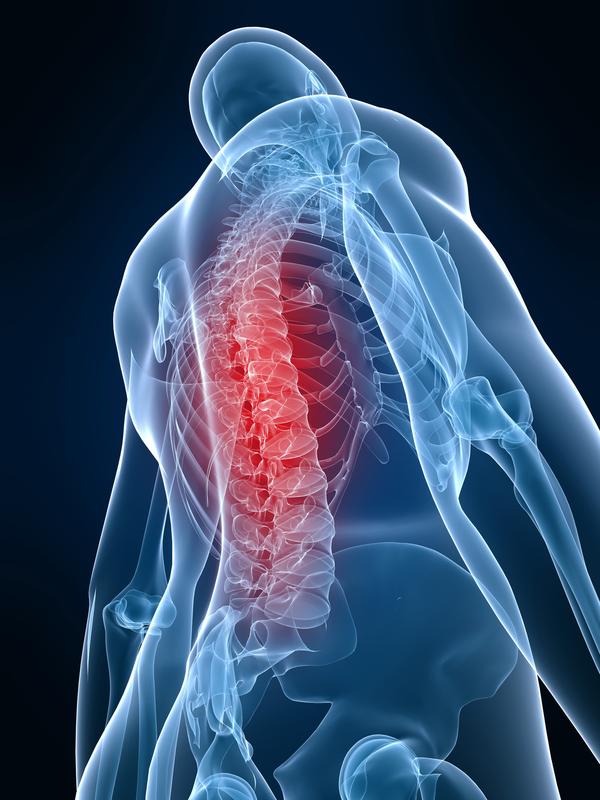Using 'Pacemakers' in spinal cord injuries

Electrical stimulation of the spinal cord below the site of injury. Copyright: European Project NEUwalk.
Researchers from Charité – Universitätsmedizin Berlin and EPFL, Lausanne have succeeded in restoring motor function following spinal cord injury. The researchers were able to show that coordinated muscle movement is the result of alternating activation patterns emanating from the spinal cord.
Newly-developed implants, which use electrical stimulation to mimic these signals, were used to target and reactivate specific segments of the spinal cord. Results from this study have been published in the current issue of the journal Nature Medicine.*
Paraplegia is the result of traumatic injury to the spinal cord. Communication between the brain and spinal cord is disrupted, which often leads to severe functional impairment and life-long paralysis. Research studies have shown that the spinal cord is capable of producing coordinated movements in response to electrical or chemical stimulation, even in the absence of signals from the brain.
“Our aim is to use electrical stimulation to restore spinal cord function below the site of injury. We are hoping to succeed in enhancing the body's own ability to produce voluntary movement by mimicking the natural spinal cord activity as closely as possible,” explains Dr. Nikolaus Wenger, who is involved in research at Charité's Department of Neurology and the Berlin Institute of Health.
Using an animal model, the team of European researchers was able to show that leg movements are associated with a wave-like activation of specific sections of the spinal cord. “In order to be able to reproduce this activity in paraplegic individuals, we developed permanent implants that are capable of selectively activating the spinal cord,” says Dr. Wenger.
Both strength and balance during locomotion can be improved by stimulating the spinal cord in the right place at the right time. The researchers' innovative implants and stimulation protocols allow the spinal cord to be activated based on continuous motion feedback.
Electrical stimulation of the spinal cord can also be used to generate movement in humans, which is why researchers are currently in the process of finding ways to translate these findings into clinical applications. This new method of stimulating the spinal cord may contribute to the development of improved treatments for patients with paraplegia. Following further developments, these new treatment approaches may also be adaptable for use in stroke research.
*N. Wenger, E. M. Moraud, J. Gandar, P. Musienko, M. Capogrosso, L. Baud, C. G Le Goff, Q. Barraud, N. Pavlova, N. Dominici, I. R. Minev, L. Asboth, A. Hirsch, S. Duis, J. Kreider, A. Mortera, O. Haverbeck, S. Kraus, F. Schmitz, J. DiGiovanna, R. van den Brand, J. Bloch, P. Detemple, S. P. Lacour, E. Bézard, S. Micera & G. Courtine. Spatiotemporal neuromodulation therapies engaging muscle synergies improve motor control after spinal cord injury. Nat Med. 2016 Feb;22(2):138-145. doi: 10.1038/nm.4025. Epub 2016 Jan 18.
Contact:
Dr. Nikolaus Wenger
Klinik und Hochschulambulanz für Neurologie
Charité – Universitätsmedizin Berlin
Tel: +49 30 450 660 206
Email:nikolaus.wenger@charite.de
http://www.charite.de/en/
http://neurologie.charite.de/en/research/
http://www.schlaganfallcentrum.de/en/
https://www.bihealth.org/en/
Media Contact
All latest news from the category: Medical Engineering
The development of medical equipment, products and technical procedures is characterized by high research and development costs in a variety of fields related to the study of human medicine.
innovations-report provides informative and stimulating reports and articles on topics ranging from imaging processes, cell and tissue techniques, optical techniques, implants, orthopedic aids, clinical and medical office equipment, dialysis systems and x-ray/radiation monitoring devices to endoscopy, ultrasound, surgical techniques, and dental materials.
Newest articles

High-energy-density aqueous battery based on halogen multi-electron transfer
Traditional non-aqueous lithium-ion batteries have a high energy density, but their safety is compromised due to the flammable organic electrolytes they utilize. Aqueous batteries use water as the solvent for…

First-ever combined heart pump and pig kidney transplant
…gives new hope to patient with terminal illness. Surgeons at NYU Langone Health performed the first-ever combined mechanical heart pump and gene-edited pig kidney transplant surgery in a 54-year-old woman…

Biophysics: Testing how well biomarkers work
LMU researchers have developed a method to determine how reliably target proteins can be labeled using super-resolution fluorescence microscopy. Modern microscopy techniques make it possible to examine the inner workings…





















